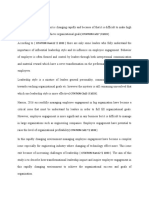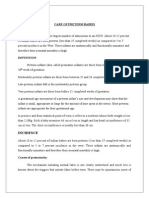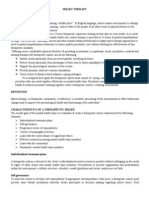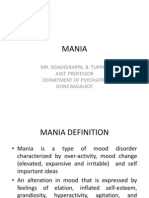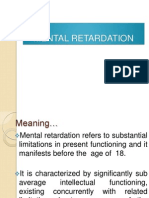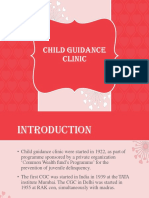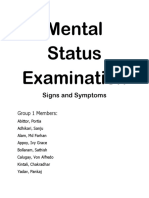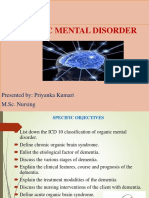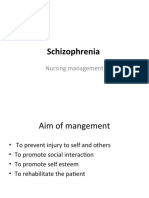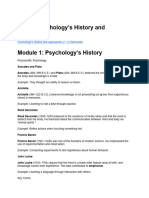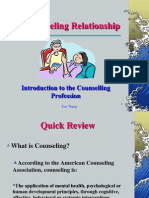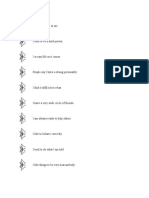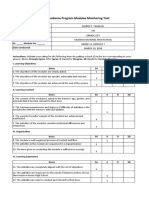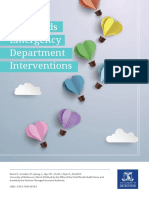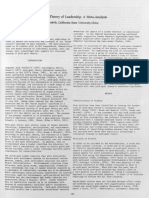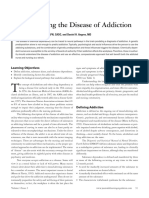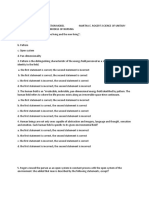Conduct Disorder
Conduct Disorder
Uploaded by
leftbysanityCopyright:
Available Formats
Conduct Disorder
Conduct Disorder
Uploaded by
leftbysanityOriginal Description:
Copyright
Available Formats
Share this document
Read this document in other languages
Did you find this document useful?
Is this content inappropriate?
Copyright:
Available Formats
Conduct Disorder
Conduct Disorder
Uploaded by
leftbysanityCopyright:
Available Formats
Specific Objectives
Content
Methodology
Time Allotment
Resources
Evaluation
1. Define Conduct Disorder
Conduct disorder involves a repetitive and persistent pattern of behavior in which the basic rights of others or major age-appropriate societal norms or rules are violated (APA, 2000). Physical aggression is common.
Essentials of Psychiatric Mental Health Nursing 5th ed. - M. Townsend (F. A. Davis, 2011) Essentials of Psychiatric Mental Health Nursing 5th ed. - M. Townsend (F. A. Davis, 2011)
2. Differentiate the
subtypes of Conduct Disorder
Childhood-Onset Type: This subtype is defined by the onset of at least one criterion characteristic of conduct disorder prior to age 10. Individuals with this subtype are usually boys, frequently display physical aggression, and have disturbed peer relationships. They may have had oppositional defiant disorder during early childhood, usually meet the full criteria for conduct disorder by puberty, and are likely to develop antisocial personality disorder in adulthood. Adolescent-Onset Type: This subtype is defined by the absence of any criteria characteristic of conduct disorder prior to age 10. They are less likely to display aggressive behaviors and tend to have more normal peer relationships than those with childhood onset type. They are also less likely to have persistent conduct disorder or develop antisocial personality disorder than those with childhood-onset type. The ratio of boys to girls is lower in adolescent-onset type than in childhood-onset type.
3. Recognize the Risk
Risk Factors of Conduct Disorder (CD)
Factors and Causes Various social factors that lead to lack of attachment to the parents or family unit of Conduct and eventually, to lack of regard for societal rules: Disorder - Early maternal rejection - Separation from parents, with no adequate alternative caregiver available
Lippincott Williams & Wilkins. Straight As in Psychiatric & Mental Health Nursing. 2006
Early institutionalization Family neglect, abuse, or violence Frequent verbal abuse from parents, teachers, or other authority figures Parental psychiatric illness, substance abuse, or marital discord Large family size, crowding, and poverty
Physical Factors and other conditions: Neurologic damage caused by low birth weight or birth complications Underarousal of the autonomic nervous system Learning impairments Insensitivity to physical pain and punishment Essentials of Psychiatric Mental Health Nursing 5th ed. - M. Townsend (F. A. Davis, 2011)
Causes of Conduct Disorder Biological Influences Genetics Studies with monozygotic and dizygotic twins as well as with non-twin siblings have revealed a significantly higher number of conduct disorders among those who have family members with the disorder (APA, 2000). Although genetic factors appear to be involved in the etiology of conduct disorders, little is yet known about the actual mechanisms involved in genetic transmission. One study found that regions on chromosomes 19 and 2 may contain genes conferring risk to conduct disorder (Dick et al, 2004). In this study, the same region on chromosome 2 was also linked to alcohol dependence. These researchers report that childhood conduct disorder is known to be associated with the susceptibility for future alcohol problems. They have concluded that these findings suggest that some of the genes contributing to alcohol dependence in adulthood may also contribute to conduct disorder in childhood.
Temperament The term temperament refers to personality traits that become evident very early in life and may be present at birth. Evidence suggests a genetic component in temperament and an association between temperament and behavioral problems later in life. Studies have shown that, without appropriate intervention, difficult temperament at age 3 has significant links to conduct disorder and movement into care or institutional life at age 17 (Bagley & Mallick, 2000). Biochemical Factors Researchers have investigated various chemicals as biological markers. Alterations in the neurotransmitters norepinephrine and serotonin have been suggested by some studies (Comings et al, 2000; Searight, Rottnek, & Abby, 2001). Some investigators have examined the possibility of testosterone association with violence. One study correlates higher levels of testosterone in pubertal boys with social dominance and association with deviant peers (Rowe et al, 2004). Psychosocial Influences Peer Relationships Social groups have a significant impact on a childs development. Peers play an essential role in the socialization of interpersonal competence, and skills acquired in this manner affect the childs long-term adjustment. Studies have shown that poor peer relations during childhood were consistently implicated in the etiology of later deviance (Ladd, 1999). Aggression was found to be the principal cause of peer rejection, thus contributing to a cycle of maladaptive behavior. .
Family Influences The following factors related to family dynamics have been implicated as contributors in the predisposition to this disorder (Foley et al, 2004; Sadock & Sadock, 2007; Ursano et al, 2008): Parental rejection Inconsistent management with harsh discipline Early institutional living Frequent shifting of parental figures Large family size Absent father Parents with antisocial personality disorder and/or alcohol dependence Marital conflict and divorce Inadequate communication patterns Parental permissiveness
4.
List down the Signs and Symptoms of Conduct Disorder
1. Aggression to people and animals a. Often bullies, threatens, or intimidates others. b. Often initiates physical fights. c. Has used a weapon that can cause serious physical harm to others (e.g., a bat, brick, broken bottle, knife, gun) d. Has been physically cruel to people. e. Has been physically cruel to animals. f. Has stolen while confronting a victim (e.g., mugging, purse snatching, extortion, armed robbery). g. Has forced someone into sexual activity. 2. Destruction of property a. Has deliberately engaged in fire setting with the intention of causing serious damage.
American Psychiatric Association. (2000). Diagnostic and statistical manual of mental disorders (4th ed.) Text revision. Washington, DC: American Psychiatric Publishing
b. Has deliberately destroyed others property (other than by fire setting). 3. Deceitfulness or theft a. Has broken into someone elses house, building, or car. b. Often lies to obtain goods or favors or to avoid obligations (i.e., cons others). c. Has stolen items of nontrivial value without confronting a victim (e.g., shoplifting, but without breaking and entering; forgery). 4. Serious violations of rules a. Often stays out at night despite parental prohibitions, beginning before age 13 years. b. Has run away from home overnight at least twice while living in parental or parental surrogate home (or once without returning for a lengthy period). c. Is often truant from school, beginning before age 13 years. B. The disturbance in behavior causes clinically significant impairment in social, academic, or occupational functioning. C. If the individual is age 18 years or older, criteria are not met for antisocial personality disorder.
5. Application of the
Nursing Process to Conduct Disorder
Background Assessment Data (Symptomatology) The classic characteristic of conduct disorder is the use of physical aggression in the violation of the rights of others. The behavior pattern manifests itself in virtually all areas of the childs life (home, school, with peers, and in the community). Stealing, lying, and truancy are common problems. The child lacks feelings of guilt or remorse.
The use of tobacco, liquor, or nonprescribed drugs, as well as the participation in sexual activities, occurs earlier than at the expected age for the peer group. Projection is a common defense mechanism. Low self-esteem is manifested by a tough guy image. Characteristics include poor frustration tolerance, irritability, and frequent temper outbursts. Symptoms of anxiety and depression are not uncommon. Level of academic achievement may be low in relation to age and IQ. Manifestations associated with ADHD (e.g., attention difficulties, impulsiveness, and hyperactivity) are very common in children with conduct disorder. Diagnosis/Outcome Identification Based on the data collected during the nursing assessment, possible nursing diagnoses for the client with conduct disorder include: Risk for other-directed violence related to characteristics of temperament, peer rejection, negative parental role models, and dysfunctional family dynamics. Impaired social interaction related to negative parental role models and impaired peer relations leading to inappropriate social behaviors. Defensive coping related to low self-esteem and dysfunctional family system. Low self-esteem related to lack of positive feedback and unsatisfactory parent/child relationship. Outcome Criteria Outcome criteria include short- and long-term goals. Timelines are individually determined. The following criteria may be used for measurement of outcomes in the care of the client with conduct disorder: The Client: Has not harmed self or others.
Interacts with others in a socially appropriate manner. Accepts direction without becoming defensive. Demonstrates evidence of increased self-esteem by discontinuing exploitative and demanding behaviors toward others. Planning/Implementation On the next sheet provides a plan of care for the child with conduct disorder using nursing diagnoses common to the disorder, outcome criteria, and appropriate nursing interventions and rationales. Evaluation Following the planning and implementation of care, evaluation is made of the behavioral changes in the child with conduct disorder. This is accomplished by determining if the goals of therapy have been achieved. Reassessment, the next step in the nursing process, may be initiated by gathering information using the following questions. Have the nursing actions directed toward managing the clients aggressive behavior been effective? Have interventions prevented harm to others or others property? Is the client able to express anger in an appropriate manner? Has the client developed more adaptive coping strategies to deal with anger and feelings of aggression? Does the client demonstrate the ability to trust others? Is he or she able to interact with staff and peers in an appropriate manner? Is the client able to accept responsibility for his or her own behavior? Is there less blaming of others? Is the client able to accept feedback from others without becoming defensive? Is the client able to verbalize positive statements about self? Is the client able to interact with others withoutengaging in manipulation?
NURSING DIAGNOSIS: RELATED TO:
RISK FOR OTHER-DIRECTED VIOLENCE Characteristics of temperament, peer rejection, negative parental role models, dysfunctional family dynamics
Outcome COUTCOME CRITERIA Short-Term Goal Client will discuss feelings of anger with nurse or therapist.
NURSING INTEVENTIONS 1. Observe clients behavior frequently through routine activities and interactions. Become aware of behaviors that indicate a rise in agitation. 2. Redirect violent behavior with physical outlets for suppressed anger and frustration. Encourage client to express anger and act as a role model for appropriate expression of anger.
RATIONALE 1. Recognition of behaviors that precede the onset of aggression may provide the opportunity to intervene before violence occurs. 2. Excess energy is released through physical activities inducing a feeling of relaxation. Discussion of situations that create anger may lead to more effective ways of dealing with them. This conveys an evidence of control over the situation and provides physical security for staff. It is the clients right to expect the use of techniques that ensure safety of the client and others by the least restrictive means.
Long-Term Goal Client will not harm others or others property. 3.
3.
4. Ensure that a sufficient number of staff is available to indicate a show of strength if necessary. 5. Administer tranquilizing medication, if ordered, or use mechanical restraints or isolation room only if situation cannot be controlled with less restrictive means.
4.
5.
NURSING DIAGNOSIS: IMPAIRED SOCIAL INTERACTION RELATED TO: Negative parental role models; impaired peer relations leading to inappropriate social behavior NURSING INTEVENTIONS 1. Develop a trusting relationship with the client. Convey acceptance of the person separate from the unacceptable behavior. 2. Long-Term Goal Client will be able to interact with staff and peers using age-appropriate, acceptable behaviors. Discuss with client which behaviors are and are not acceptable. Describe in matter-of-fact manner the consequence of unacceptable behavior. Follow through. RATIONALE 1. Unconditional acceptance increases feeling of self-worth.
Outcome COUTCOME CRITERIA Short-Term Goal Client will interact in age-appropriate manner with nurse in one-to-one relationship within 1 week.
2.
Aversive reinforcement can alter or extinguish undesirable behaviors.
3. Provide group situations for client.
3. Appropriate social behavior is often learned from the positive and negative feedback of peers.
NURSING DIAGNOSIS: DEFENSIVE COPING RELATED TO: Low self-esteem and dysfunctional family system
OUTCOME CRITERIA Short-Term Goal Client will verbalize personal responsibility for difficulties experienced in interpersonal relationships within (time period reasonable for client). Long-Term Goal Client will accept responsibility for own behaviors and interact with others without becoming defensive.
NURSING INTEVENTIONS 1. Explain to client the correlation between feelings of inadequacy and the need for acceptance from others and how these feelings provoke defensive behaviors, such as blaming others for own behaviors. 2. Provide immediate, matter-of-fact, nonthreatening feedback for unacceptable behaviors.
RATIONALE 1. Recognition of the problem is the first step in the change process toward resolution.
2. Client may not realize how these behaviors are being perceived by others.
3. Help identify situations that provoke defensiveness and practice through role-play more appropriate responses. 4. Provide immediate positive feedback for acceptable behaviors.
3. Role-playing provides confidence to deal with difficult situations when they actually occur.
4. Positive feedback encourages repetition, and immediacy is significant for these children who respond to immediate gratification.
NURSING DIAGNOSIS: LOW SELF-ESTEEM RELATED TO: Lack of positive feedback and unsatisfactory parent/child relationship NURSING INTEVENTIONS 1. Ensure that goals are realistic. Short-Term Goal 2. Client will participate in own self-care and discuss with nurse aspects of self about which he or she feels good. 3. Long-Term Goal Client will demonstrate increased feelings of self-worth by verbalizing positive statements about self and exhibiting fewer manipulative behaviors. Plan activities that provide opportunities for success. Convey unconditional acceptance and positive regard. RATIONALE 1. Unrealistic goals set client up for failure, which diminishes self-esteem. 2. Success enhances self-esteem.
OUTCOME CRITERIA
3.
Communicating that client is a worthwhile human being may increase self-esteem.
4. Set limits on manipulative behavior. Take caution not to reinforce manipulative behaviors by providing desired attention. Identify the consequences of manipulation. Administer consequences matter-of-factly when manipulation occurs. 5. Help client understand that he or she uses this behavior in order to try to increase own self-esteem. Interventions should refl ect other actions to accomplish this goal.
4. Aversive consequences may work to decrease unacceptable behaviors.
5. When the client feels better about self, the need to manipulate others will diminish.
You might also like
- 1.2 Problem Statement:: (CITATION Col17 /L 1033)Document3 pages1.2 Problem Statement:: (CITATION Col17 /L 1033)Safi SheikhNo ratings yet
- Alcohol Use DisorderDocument28 pagesAlcohol Use DisorderAkhilesh Parab33% (3)
- Mental Status Examination FormatDocument7 pagesMental Status Examination FormatMala Rasaily100% (8)
- Difference Between Neurosis and PsychosisDocument4 pagesDifference Between Neurosis and PsychosisShaheen Khan Warsi100% (1)
- Mental Retardation (Lesson Plan)Document20 pagesMental Retardation (Lesson Plan)Tannu Dahiya100% (3)
- Mental RetardationDocument7 pagesMental RetardationNikhil MohanNo ratings yet
- Delirium Case PresentationDocument14 pagesDelirium Case PresentationWong Chui YeeNo ratings yet
- Adjustment Reaction To SchoolDocument6 pagesAdjustment Reaction To SchoolYatharth DateerNo ratings yet
- CDNCPDocument2 pagesCDNCPGooph BusterNo ratings yet
- Management of Psychiatric Problem With ChildDocument77 pagesManagement of Psychiatric Problem With ChildRahul DhakerNo ratings yet
- The Psychiatric Mental Status Exam (MSE)Document4 pagesThe Psychiatric Mental Status Exam (MSE)dev100% (1)
- DisulfiramDocument15 pagesDisulfiramvarsha thakur100% (1)
- Mieliu TherapyDocument7 pagesMieliu TherapyRENJULALNo ratings yet
- Mohd Rafi'uddin Hamidon 01200910 0070Document13 pagesMohd Rafi'uddin Hamidon 01200910 0070Mohd Rafi50% (2)
- Nursing Care Plan For A Patient With SchizophreniaDocument14 pagesNursing Care Plan For A Patient With SchizophreniaJerilee SoCute WattsNo ratings yet
- Annotated BibliographyDocument4 pagesAnnotated Bibliographymerin sunilNo ratings yet
- Assessing Preterm BabyDocument5 pagesAssessing Preterm BabyJoyce Kathreen Ebio LopezNo ratings yet
- Child Accident PreventionDocument6 pagesChild Accident PreventionDenekew Getahun100% (2)
- Care of Preterm Babies FinalDocument33 pagesCare of Preterm Babies Finalchinchu100% (1)
- Ocd MseDocument8 pagesOcd MseGogs Ediza AlejoNo ratings yet
- Nursing Management of Patients With AutismDocument30 pagesNursing Management of Patients With AutismPolPelonio100% (1)
- Milieu TherapyDocument4 pagesMilieu TherapyManu Sethi100% (1)
- Pediatric - 18.04.20-Child Guidance ClinicDocument29 pagesPediatric - 18.04.20-Child Guidance ClinicAjeeshNo ratings yet
- Recreational Therapy Presentee: Sukhdeep Kaur Msc. (N) 1 YearDocument26 pagesRecreational Therapy Presentee: Sukhdeep Kaur Msc. (N) 1 YearSatbir GillNo ratings yet
- ManiaDocument17 pagesManiaSiddaveerappa Balappa TuppadNo ratings yet
- Behavioural Problems in ChildrenDocument49 pagesBehavioural Problems in ChildrenAshly Nygil100% (1)
- Care of Terminally Ill PatientDocument64 pagesCare of Terminally Ill PatientSilpa Jose T100% (1)
- SCHIZOPHRENIADocument32 pagesSCHIZOPHRENIANasriah Macadato100% (1)
- NCP On Mental RetardationDocument20 pagesNCP On Mental RetardationSARITA SHARMANo ratings yet
- Terminologies Used in Psy - NursingDocument56 pagesTerminologies Used in Psy - NursingTinju Joy100% (1)
- SGRD College of Nursing: Lesson Plan of Microteaching On (Play Therapy)Document8 pagesSGRD College of Nursing: Lesson Plan of Microteaching On (Play Therapy)MonikaNo ratings yet
- A Lesson Plan On National Mental Health ProgrammeDocument17 pagesA Lesson Plan On National Mental Health ProgrammeLeo Jacob100% (3)
- MHN: Unit XV: Adjustment and Impulse Control Disorders Adjustment DisordersDocument12 pagesMHN: Unit XV: Adjustment and Impulse Control Disorders Adjustment Disordersmadhurima kundu100% (1)
- 5-Child Guidance ClinicsDocument4 pages5-Child Guidance ClinicsSwati LalNo ratings yet
- 5-Child Guidance ClinicsDocument13 pages5-Child Guidance ClinicsSwati LalNo ratings yet
- Lesson Plan On Eating DisorderDocument17 pagesLesson Plan On Eating DisorderAnkush Kulat PatilNo ratings yet
- Terminal Illness and DeathDocument37 pagesTerminal Illness and DeathJAYSON KING100% (2)
- Adhd New ContentDocument9 pagesAdhd New ContentAsha jiluNo ratings yet
- 2.A Ndera CaseDocument14 pages2.A Ndera CaseNsengimana Eric MaxigyNo ratings yet
- Mental RetardationDocument49 pagesMental RetardationRENJULAL100% (4)
- Child Guidance ClinicDocument12 pagesChild Guidance Clinicmanish dafda0% (1)
- Mental Health Nursing: Class PresentationDocument16 pagesMental Health Nursing: Class PresentationAthul Krishnan100% (4)
- Mental Health TeamDocument3 pagesMental Health Teammanu sethiNo ratings yet
- BPADDocument24 pagesBPADsuresh sataguni100% (1)
- Mental Retardation Lesson PlanDocument10 pagesMental Retardation Lesson Plansp2056251No ratings yet
- AtpdDocument48 pagesAtpddrkadiyala2100% (2)
- MHN, I (U), 6Document51 pagesMHN, I (U), 6akila100% (1)
- Group 1 Mental Status ExaminationDocument12 pagesGroup 1 Mental Status ExaminationPankaj100% (3)
- Hospital Environment For Sick ChildDocument10 pagesHospital Environment For Sick ChildKhushbu KatariaNo ratings yet
- Family Health Nursing: Ms - Neethu Vincent Asst Professor KVM College of NursingDocument9 pagesFamily Health Nursing: Ms - Neethu Vincent Asst Professor KVM College of NursingNeethu VincentNo ratings yet
- Antenatal Aspect Preventive PeadiarricsDocument28 pagesAntenatal Aspect Preventive PeadiarricsYashoda SatputeNo ratings yet
- Mental Status Examination: Identification DataDocument5 pagesMental Status Examination: Identification Datailakkiya ilakkiya100% (1)
- Care of Preterm Babies: Chinchu.MDocument59 pagesCare of Preterm Babies: Chinchu.MChinchu MohanNo ratings yet
- 18 Maternal Deprivation SeminarDocument24 pages18 Maternal Deprivation SeminarRashmi Negi50% (2)
- Causes and Treatment of ManiaDocument11 pagesCauses and Treatment of ManiaGEETA MOHAN100% (2)
- Organic Mental Disorder: Presented By: Priyanka Kumari M.Sc. NursingDocument50 pagesOrganic Mental Disorder: Presented By: Priyanka Kumari M.Sc. NursingHardeep KaurNo ratings yet
- Schizophrenia Nursing ManagementDocument56 pagesSchizophrenia Nursing ManagementHumphrey100% (1)
- Conduct DisordersDocument17 pagesConduct DisordersMamta PooniaNo ratings yet
- Behavioral Problems in ChildrenDocument21 pagesBehavioral Problems in ChildrenAnanya arenavaruNo ratings yet
- SW 109 Topic 5 MaladjustmentDocument11 pagesSW 109 Topic 5 MaladjustmentROSARIO CHARLENE IRISH P.No ratings yet
- Conduct Disorder: Definition, Statistics, Parental Role and InterventionDocument10 pagesConduct Disorder: Definition, Statistics, Parental Role and InterventionMayang Espera Archivos SarmientoNo ratings yet
- Module - 1 Psychology's History MeyerDocument4 pagesModule - 1 Psychology's History Meyerboomboomboi0420No ratings yet
- Counseling PrinciplesDocument52 pagesCounseling Principleslehsem20006985100% (2)
- Personality TestDocument12 pagesPersonality TestNatural Gas Metering Sui Norhern Gas Pipelines Ltd.No ratings yet
- CGP-monitoring-tool MODULE 7 (M.TAGALOG)Document2 pagesCGP-monitoring-tool MODULE 7 (M.TAGALOG)MarifeNo ratings yet
- The Adolescent Brain: New Research and Implications For Young People Transitioning From Foster CareDocument56 pagesThe Adolescent Brain: New Research and Implications For Young People Transitioning From Foster CareThe Vancouver Sun100% (1)
- Chapter 1, Introduction To Consumer BehaviorDocument5 pagesChapter 1, Introduction To Consumer BehaviorMuthusamy Senthilkumaar100% (2)
- Safewards Ed Interventions PDFDocument7 pagesSafewards Ed Interventions PDFInstalasi RehabilitasiNo ratings yet
- The Five Spiritual Faculties-ConzeDocument41 pagesThe Five Spiritual Faculties-ConzeGeorge PetreNo ratings yet
- Educational Technology 2: Activity # 1 - Making My Learning GlobalDocument3 pagesEducational Technology 2: Activity # 1 - Making My Learning GlobalAkira K. ChanNo ratings yet
- Gen 002 Lesson 3Document6 pagesGen 002 Lesson 3Ellah MaeNo ratings yet
- Values and Professional EthicsDocument4 pagesValues and Professional EthicsJonyel De LeonNo ratings yet
- Celebrity Worship ThesisDocument6 pagesCelebrity Worship ThesisCollegePapersToBuyMadison100% (2)
- Psychological Influences On Consumer BehaviorDocument11 pagesPsychological Influences On Consumer BehaviorNofri AndriNo ratings yet
- 3 - Market Research Six Step ModelDocument20 pages3 - Market Research Six Step ModelDiksha SukhejaNo ratings yet
- Path-Goal Theory of Leadership: A Meta-Analysis: Julie Indvik, California State University-ChicoDocument6 pagesPath-Goal Theory of Leadership: A Meta-Analysis: Julie Indvik, California State University-ChicoMuhammet Baran ÖZÇEKENNo ratings yet
- Understanding The Disease of Addiction: Kathy Bettinardi-Angres, MS, RN, APN, CADC, and Daniel H. Angres, MDDocument7 pagesUnderstanding The Disease of Addiction: Kathy Bettinardi-Angres, MS, RN, APN, CADC, and Daniel H. Angres, MDESTHER OGODONo ratings yet
- Semene MikreDocument76 pagesSemene MikreerkiyhunNo ratings yet
- Lesson Plan Academic IntegrityDocument2 pagesLesson Plan Academic Integrityapi-380548110No ratings yet
- English Lecture NotesDocument118 pagesEnglish Lecture NotesHimanish KoyalkarNo ratings yet
- Job InterviewDocument26 pagesJob InterviewRuri McmillianNo ratings yet
- Research Proposal: 1.0 Statement of The ProblemDocument9 pagesResearch Proposal: 1.0 Statement of The ProblemselbalNo ratings yet
- (Educational Futures Rethinking Theory and Practice 62) Inna Semetsky, Andrew Stables (Eds.) - Pedagogy and Edusemiotics - Theoretical Challenges - Practical Opportunities (2014, SensePublishers)Document196 pages(Educational Futures Rethinking Theory and Practice 62) Inna Semetsky, Andrew Stables (Eds.) - Pedagogy and Edusemiotics - Theoretical Challenges - Practical Opportunities (2014, SensePublishers)FabioEnriqueParraHerreraNo ratings yet
- Session # 5Document2 pagesSession # 5J tanieeNo ratings yet
- Dornyei Muir 2019 CreatingamotivatingclassroomenvironmentDocument19 pagesDornyei Muir 2019 CreatingamotivatingclassroomenvironmentAnh Dung NguyenNo ratings yet
- Online-Curriculum-Chapter 8 & 9Document11 pagesOnline-Curriculum-Chapter 8 & 9Lovelyn MaristelaNo ratings yet
- Fatherless Children You Can Be Whoever You Want To BeDocument7 pagesFatherless Children You Can Be Whoever You Want To Beapi-241746742No ratings yet
- Architecture TownDocument9 pagesArchitecture TownAbhishek AbNo ratings yet
- Emotion, Space and Society: Kye AskinsDocument10 pagesEmotion, Space and Society: Kye AskinsLMC UdMNo ratings yet
